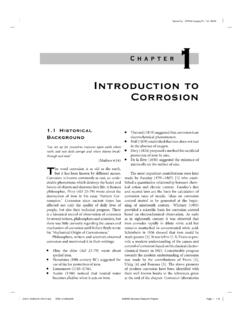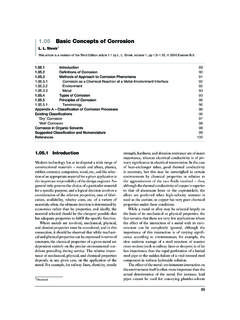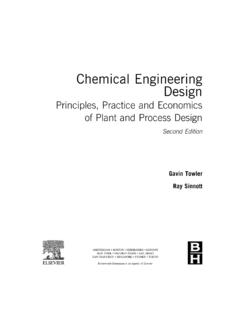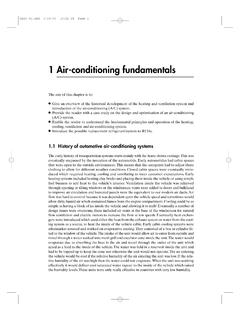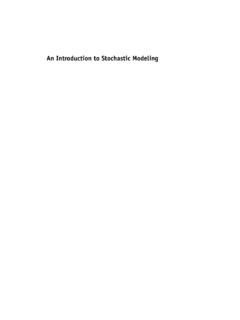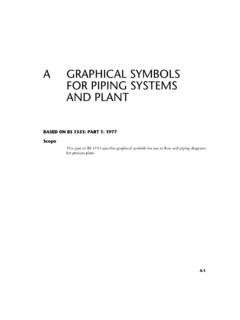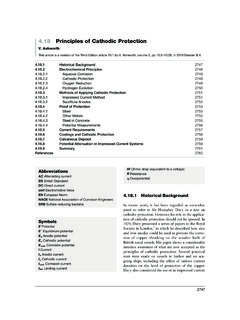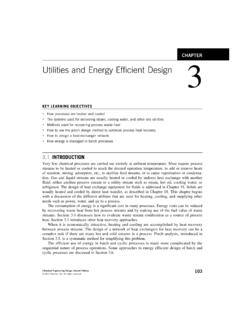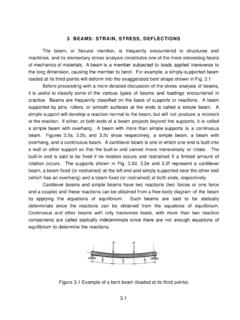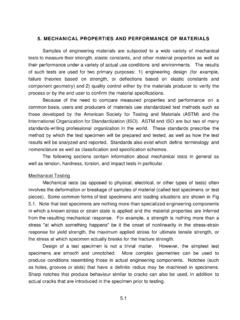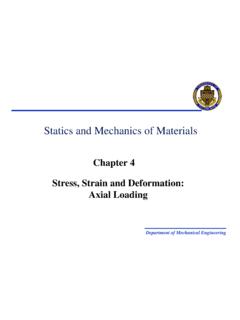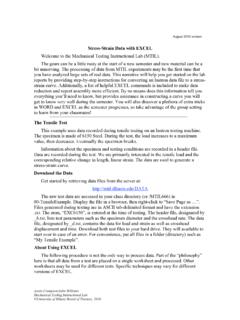Transcription of CHAPTER ONE - Elsevier
1 : 41 Page 1 CHAPTERONESTRESSES AND IntroductionThe theory of plasticity is the branch of mechanics that deals with the calculationof stresses and strains in a body, made of ductile material, permanently deformedby a set of applied forces. The theory is based on certain experimental observationson the macroscopic behavior of metals in uniform states of combined stresses. Theobserved results are then idealized into a mathematical formulation to describe thebehavior of metals under complex stresses. Unlike elastic solids, in which the state ofstrain depends only on the final state of stress , the deformation that occurs in a plasticsolid is determined by the complete history of the loading. The plasticity problemis, therefore, essentially incremental in nature, the final distortion of the solid beingobtained as the sum total of the incremental distortions following the strain metal may be regarded as macroscopically homogeneous and isotropic whenthe small crystal grains forming the aggregate are distributed with random orienta-tions.
2 As a result of plastic deformation, the crystallographic directions graduallyrotate toward a common axis, producing apreferred orientation. An initiallyisotropic material thereby becomes anisotropic, and its mechanical properties varywith direction. The development of anisotropy with progressive cold work and theresulting strain -hardening are too complex to be successfully incorporated in the the-oretical framework. In the mathematical theory of plasticity, it is generally assumedthat the material remains isotropic throughout the deformation irrespective of thedegree of cold work. Since the strain -hardening characteristic of a metal in a complexstate of stress can be related to that in uniaxial tension or compression, it is necessaryto examine the uniaxial stress strain behavior in some detail before considering thegeneral theory of : 41 Page 22theory of plasticityThe plastic deformation in a single crystal is generally produced by slip, whichis the sliding of adjacent blocks of the crystal along definite crystallographic planes,called slip planes.
3 The boundary line separating the slipped region of a crystal fromthe neighboring unslipped region is called movement of the dis-location, which is responsible for the slip, is initiated by a line defect causing a localconcentration of stress . Slip usually occurs on those planes which are most denselypacked with atoms. The magnitude and direction of the relative movement in a slipis specified by a vector known as theBurgers vector. A dislocation is said to be oneof unit strength when the magnitude of the Burgers vector is equal to one atomicspacing. The termsedge dislocationandscrew dislocationare used to describe thesituations where the Burgers vector is normal and parallel respectively to the dis-location line. In general, a dislocation is partly edge and partly screw in character,and the dislocation line forms a curve or a closed loop.
4 In a polycrystalline metal, the crystallographic orientation changes from onegrain to the next through a narrow transition zone, or grain boundary, which acts asan effective barrier to slip. Dislocations pile up along the active slip planes at thegrain boundaries, the effect of which is to oppose the generations of new the applied stress is increased to a critical value, the shear stress developedat the head of the dislocation pile-up becomes large enough to cause dislocationmovement across the boundary. The dislocation pile-up is mainly responsible forstrain-hardening of the metal in the early stages of plastic deformation. The rateof hardening of the polycrystalline metal is always higher than that of the singlecrystal, where the increase in yield stress is caused by dislocations interacting withone another and with foreign atoms serving as barriers.
5 The dislocation interactionscontrol the yield strength of a polycrystalline metal only in the later stages of the temperature of the strain -hardened metal is progressively increased, thecold-worked state becomes more and more unstable, and the material eventuallyreverts to the unstrained state. The overall process of heat treatment that restoresthe ductility to the cold-worked metal is known temperatureat which there is a marked decrease in hardness of the metal is known as therecrystallization temperature. The dislocation density decreases considerably onrecrystallization, and the cold-worked structure is replaced by a set of new strain -free grains. The greater the degree of cold-work, the lower the temperature necessaryfor recrystallization, and smaller the resulting grain size.
6 In ductile metals, under favorable conditions, plastic deformation can con-tinue to a very large extent without failure by fracture. Large plastic strains do occur For a complete discussion, see A. H. Cottrell,Dislocations and Plastic Flow in Crystals,Clarendon Press, Oxford (1953); W. T. Read,Dislocations in Crystals, McGraw-Hill BookCompany, New York (1953); J. Friedel,Dislocations, Addison-Wesley Publishing Company, Read-ing, Mass. (1964); F. R. N. Nabarro,Theory of Crystal Dislocations, Clarendon Press, Oxford (1967);D. Hull,Introduction to Dislocations, 2d ed., Pergamon Press, Oxford (1975). See, for example, G. E. Dieter,Mechanical Metallurgy, Chap. 5, 2d ed., McGraw-Hill BookCompany, New York (1976). See also R.
7 W. K. Honeycombe,The Plastic Deformation of Metals,2ded., Edward Arnold, London (1984). : 41 Page 3stresses and strains3in many metal-working processes, which constitute an important area of applicationof the theory of plasticity. While elastic strains may be neglected in such problems,the continued change in geometry of the workpiece must be allowed for in the the-oretical treatment. Severe plastic strains are produced locally in certain mechanicaltests such as the hardness test and the notch tensile test. The significance of thesetests cannot be fully appreciated without a knowledge of the extent of the plasticzone and the associated state of stress . Situations in which elastic and plastic strainsare comparable in magnitude arise in a number of important structural problemswhen the loading is continued beyond the elastic limit.
8 Structural designs based onthe estimation of collapse loads are more economical than elastic designs, since theplastic method takes full advantage of the available ductility of the The stress strain Behavior(i)The true stress strain curveThe stress strain curve of an annealed materialin simple tension is found to coincide with that in simple compression when the truestress is plotted against the true or natural strain . Thetrue stress , defined as theload divided by the current cross-sectional area of the specimen, can be significantlydifferent from thenominal stress , which is the load per unit original area of cross-section. Letldenote the current length of a tensile specimen anddlthe increase inlength produced by a small increment of the stress .
9 Then the true strain increases bythe amountd =dl/l. If the initial length isl0, the total strain is =ln(l0/l), calledthe true ornatural strain . For a specimen uniformly compressed from an initialheighth0to a final heighth, the magnitude of the natural strain is =ln(h0/h). Theconventional orengineering strain e, on the other hand, is the amount of extensionor contraction per unit original length or height. It follows that =ln(l+e)inthecase of tension, and = ln(l e) in the case of compression. Thus becomesprogressively lower thanein tension, and higher thanein compression, as thedeformation is continued in the plastic shows the true stress strain curve of a typical annealed materialin simple tension. So long as the stress is sufficiently small, the material behaveselastically, and the original size of the specimen is regained on removal of theapplied load.
10 The initial part of the stress strain curve is a straight line of slopeE, which is known as Young s modulus. The pointArepresents theproportionallimitat which the linear relationship between the stress and the strain ceases tohold. The elastic range generally extends slightly beyond the proportional most metals, the transition from elastic to plastic behavior is gradual, owing tosuccessive yielding of the individual crystal grains. The location of theyield pointBis, therefore, largely a matter of convention. The corresponding stressY, knownas the yield stress , is generally defined as that for which a specified small amount ofpermanent deformation is observed. For theoretical purposes, it is often convenient The concept of natural strain has been introduced by P.
